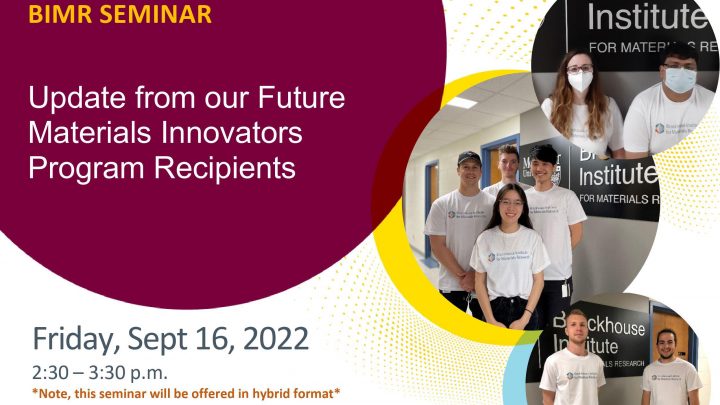BIMR Seminar: Update from our Future Materials Innovators Program Recipients
Sep 16, 2022
2:30PM to 4:30PM

Date/Time
Date(s) - 16/09/2022
2:30 pm - 4:30 pm
Categories
1- Single-walled Carbon Nanotube-doped Hydrogel Waveguides, by Billy Deng, Alex Ly, Dusan Srdic and Kevin Vaughan (Saravanamuttu and Adronov Research groups)
Our collaboration is fabricating a microscale soft material that can both direct light and conduct an electrical current. Using a photosensitive hydrogel, we are able to generate self-trapped beams of light and inscribe waveguiding structures. Embedded in the hydrogel will be single-walled carbon nanotubes, which are potent electrical conductors. These hydrogel waveguiding structures will be versatile interfaces that are both optically and electronically (i.e., optoelectronically) responsive, for use in nanoscale sensing, connections in fiber-optic cables as photodiodes, and bendable circuitry in biological applications.
2- Using correlative light and electron microscopy to investigate the influence of genetic modifications on the quantity and quality of magnetite crystals synthesized by magnetotactic bacteria, by Shariful Sakib and Alessandra Merlo (Grandfield and Fradin Research groups)
Magnetite nanocrystals synthesized by magnetotactic bacteria can potentially be used for a great number of applications, given their purity and dimensions. Initially, the aim is to overexpress, Mms6, one of the key proteins responsible for the production of these nanocrystals. Correlative light-electron microscopy is then used to address the effects of this genetic manipulation on the production and characteristics of magnetite nanocrystals produced by the modified bacteria.
3- Establishing structural dependency of BBB permeable systems, by Joseph Maggisano and Rik Chuiko (Bujold and Ayers Research groups)
Oligonucleotides are a class of biomolecules composed of short synthetic strands of nucleic acids and their derivatives, which harness the potential to treat a variety of genetic and neurodegenerative diseases. However, limitations of their use for medicinal purposes include poor delivery, nuclease degradation, and cell permeability, including penetration of the blood brain barrier (BBB). To reduce the time and cost associated with generating a library of diverse spherical nucleic acid architectures, we aim to develop a machine learning model that can (1) find important functional groups that confer increased BBB permeability and (2) predict the permeability of oligonucleotide systems that contain these appended functional groups.
In-Person: ABB 102
Online: https://mcmaster.zoom.us/j/97750134582?pwd=bWYvQlE4UUdCbi9CcStuQVo0WC9XUT09
Followed by a BIMR Reception!
To kick off the start of our 2022-2023 Seminars Season and celebrate being back in person after 2 years of not seeing each other, we are pleased to invite all our members to a Reception after the Future Materials Innovators Seminar. Join us to share a few appetizers and mingle with your colleagues. We have so much to catch up on, so we are excited for this opportunity to welcome everyone again.
Reception to follow the Seminar just outside room ABB 102.

